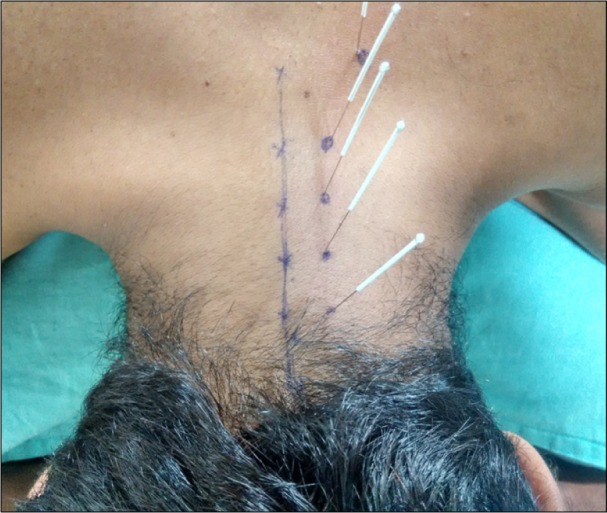Effects of Intramuscular Electrical Stimulation Using Inversely Placed Electrodes on Myofascial Pain Syndrome in the Shoulder: A Case Series
- Affiliations
-
- 1Department of Neuro-Physiotherapy, Nitte Institute of Physiotherapy, Karnataka, India. suku729@gmail.com
- 2Department of Orthopaedics, K. S. Hegde Medical Academy, Karnataka, India.
- 3Department of Orthopaedic-Physiotherapy, Nitte Institute of Physiotherapy, Karnataka, India.
- KMID: 2365357
- DOI: http://doi.org/10.3344/kjp.2016.29.2.136
Abstract
- Myofascial pain syndrome (MPS) is one of the common musculoskeletal conditions of the shoulder which may develop sensory-motor and autonomic dysfunctions at the various level of the neuromuscular system. The pain and dysfunction caused by MPS were primarily treated with physical therapy and pharmacological agents in order to achieve painfree movements. However, in recent years intramuscular electrical stimulation (IMES) with conventional electrode placement was used by researchers to maximise therapeutic values. But, in this study an inverse electrode placement was used to deliver electrical impulses intramuscularly to achieve neuro-modulation at the various level of the nervous system. Nine patients with MPS were treated with intramuscular electrode stimulation using inversely placed electrodes for a period of three weeks. All nine subjects recovered from their shoulder pain and disability within the few weeks of intervention. So, this inverse electrode placement may be more appropriate for chronic pain management.
Keyword
MeSH Terms
Figure
Cited by 3 articles
-
Optimal Cut-Off Value of the Coracohumeral Ligament Area as a Morphological Parameter to Confirm Frozen Shoulder
Hyung Rae Cho, Byong Hyon Cho, Keum Nae Kang, Young Uk Kim
J Korean Med Sci. 2020;35(15):e99. doi: 10.3346/jkms.2020.35.e99.Inverse Electrode Placement May Help to Improve Electrotherapeutic Effects in the Field of Chronic Pain Management
Sukumar Shanmugam
Korean J Pain. 2016;29(3):202-204. doi: 10.3344/kjp.2016.29.3.202.Effectiveness of intramuscular electrical stimulation using conventional and inverse electrode placement methods on pressure pain threshold and electromyographic activity of the upper trapezius muscle with myofascial trigger points: a randomized clinical trial
Sukumar Shanmugam, Fabio Vieira dos Anjos, Arthur de Sá Ferreira, Ramprasad Muthukrishnan, Praveen Kumar Kandakurti, Satheeskumar Durairaj
Korean J Pain. 2025;38(2):187-197. doi: 10.3344/kjp.24332.
Reference
-
1. Simons DG, Travell JG, Simons LS. Myofascial pain and dysfunction: the trigger point manual. Baltimore, MD: Williams & Wilkins;1999.2. Bron C, Dommerholt J, Stegenga B, Wensing M, Oostendorp RA. High prevalence of shoulder girdle muscles with myofascial trigger points in patients with shoulder pain. BMC Musculoskelet Disord. 2011; 12:139. PMID: 21711512.
Article3. Gerwin RD. Classification, epidemiology, and natural history of myofascial pain syndrome. Curr Pain Headache Rep. 2001; 5:412–420. PMID: 11560806.
Article4. Fernández-de-las-Peñas C, Dommerholt J. Myofascial trigger points: peripheral or central phenomenon? Curr Rheumatol Rep. 2014; 16:395. PMID: 24264721.
Article5. Dommerholt J, del Moral OM, Grobli C. Trigger point dry needling. J Man Manip Ther. 2006; 14:E70–E87.
Article6. Chu J, Schwartz I. Etoims twitch relief method in chronic refractory myofascial pain (CRMP). Electromyogr Clin Neurophysiol. 2008; 48:311–320. PMID: 18837197.7. Gondin J, Cozzone PJ, Bendahan D. Is high-frequency neuromuscular electrical stimulation a suitable tool for muscle performance improvement in both healthy humans and athletes? Eur J Appl Physiol. 2011; 111:2473–2487. PMID: 21909714.
Article8. Szecsi J, Fornusek C, Krause P, Straube A. Low-frequency rectangular pulse is superior to middle frequency alternating current stimulation in cycling of people with spinal cord injury. Arch Phys Med Rehabil. 2007; 88:338–345. PMID: 17321827.
Article9. Lee SH, Chen CC, Lee CS, Lin TC, Chan RC. Effects of needle electrical intramuscular stimulation on shoulder and cervical myofascial pain syndrome and microcirculation. J Chin Med Assoc. 2008; 71:200–206. PMID: 18436503.
Article10. Rainey CE. The use of trigger point dry needling and intramuscular electrical stimulation for a subject with chronic low back pain: a case report. Int J Sports Phys Ther. 2013; 8:145–161. PMID: 23593553.11. Lucas KR, Polus BI, Rich PA. Latent myofascial trigger points: their effects on muscle activation and movement efficiency. J Bodywork Movement Ther. 2004; 8:160–166.
Article12. Shah JP, Danoff JV, Desai MJ, Parikh S, Nakamura LY, Phillips TM, et al. Biochemicals associated with pain and inflammation are elevated in sites near to and remote from active myofascial trigger points. Arch Phys Med Rehabil. 2008; 89:16–23. PMID: 18164325.
Article13. Ga H, Choi JH, Park CH, Yoon HJ. Dry needling of trigger points with and without paraspinal needling in myofascial pain syndromes in elderly patients. J Altern Complement Med. 2007; 13:617–624. PMID: 17718644.
Article14. Shanmugam S, Shetty K, Mathias L. Dry needling effects on non-specific cervical radiculopathic pain and dysfunction: a case report. Int J Ther Rehabil Res. 2015; 4:21–25.
Article15. Rock JM, Rainey CE. Treatment of nonspecific thoracic spine pain with trigger point dry needling and intramuscular electrical stimulation: a case series. Int J Sports Phys Ther. 2014; 9:699–711. PMID: 25328832.
- Full Text Links
- Actions
-
Cited
- CITED
-
- Close
- Share
- Similar articles
-
- Intramuscular Stimulation Therapy
- The Effect of Intramuscular Electrical Stimulation in Myofascial Pain Syndrome
- The Effect of Intramuscular Stimulation on Otalgia due to Myofascial Pain Syndrome by Contraction of Trapezius Muscle
- Effects of Intramuscular Stimulation in Myofascial Pain Syndrome of Upper Trapezius Muscle
- The Effect of Intramuscular Low Frequency Electrical Stimulation for Hemiplegic Shoulder Pain


